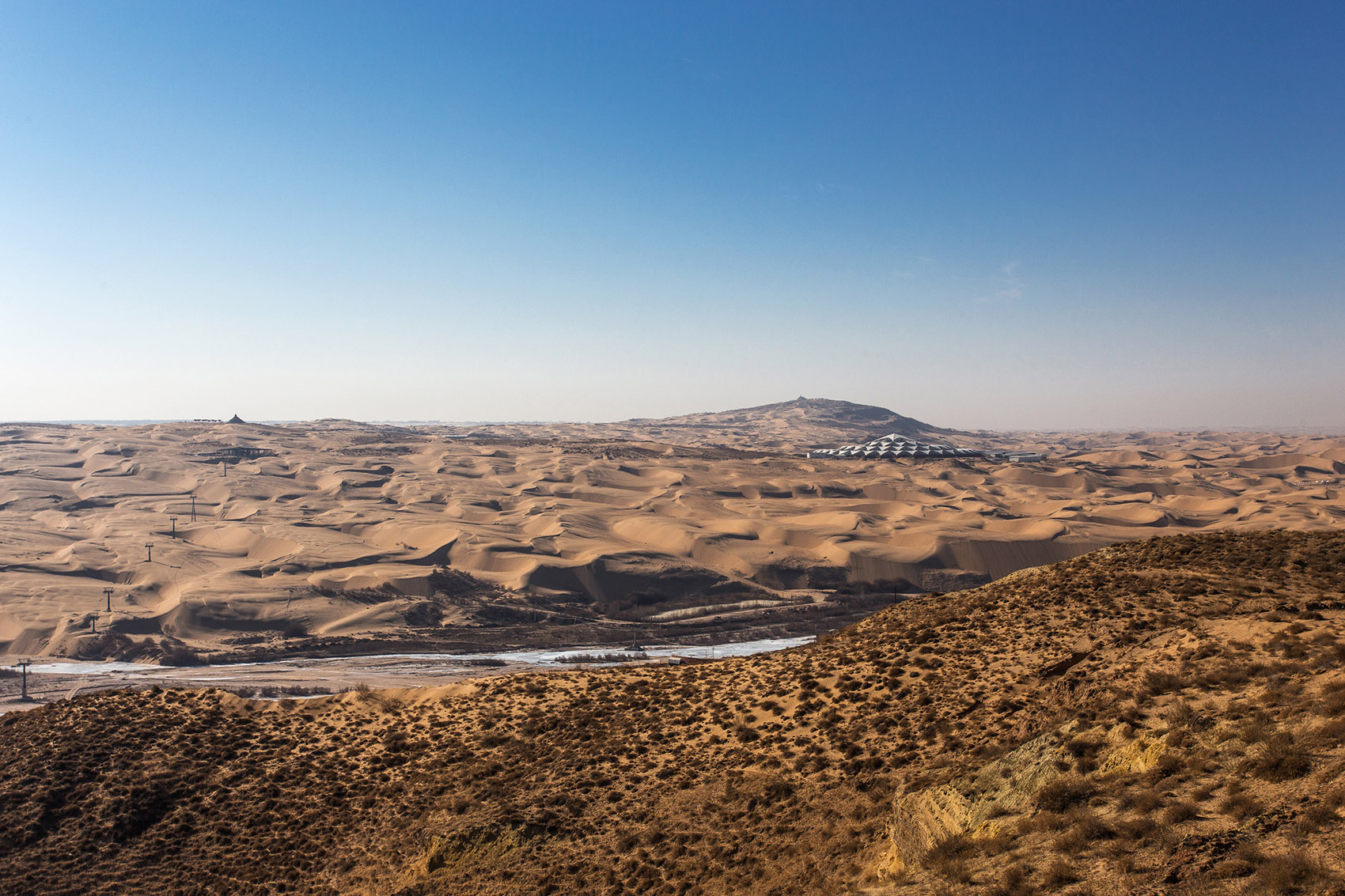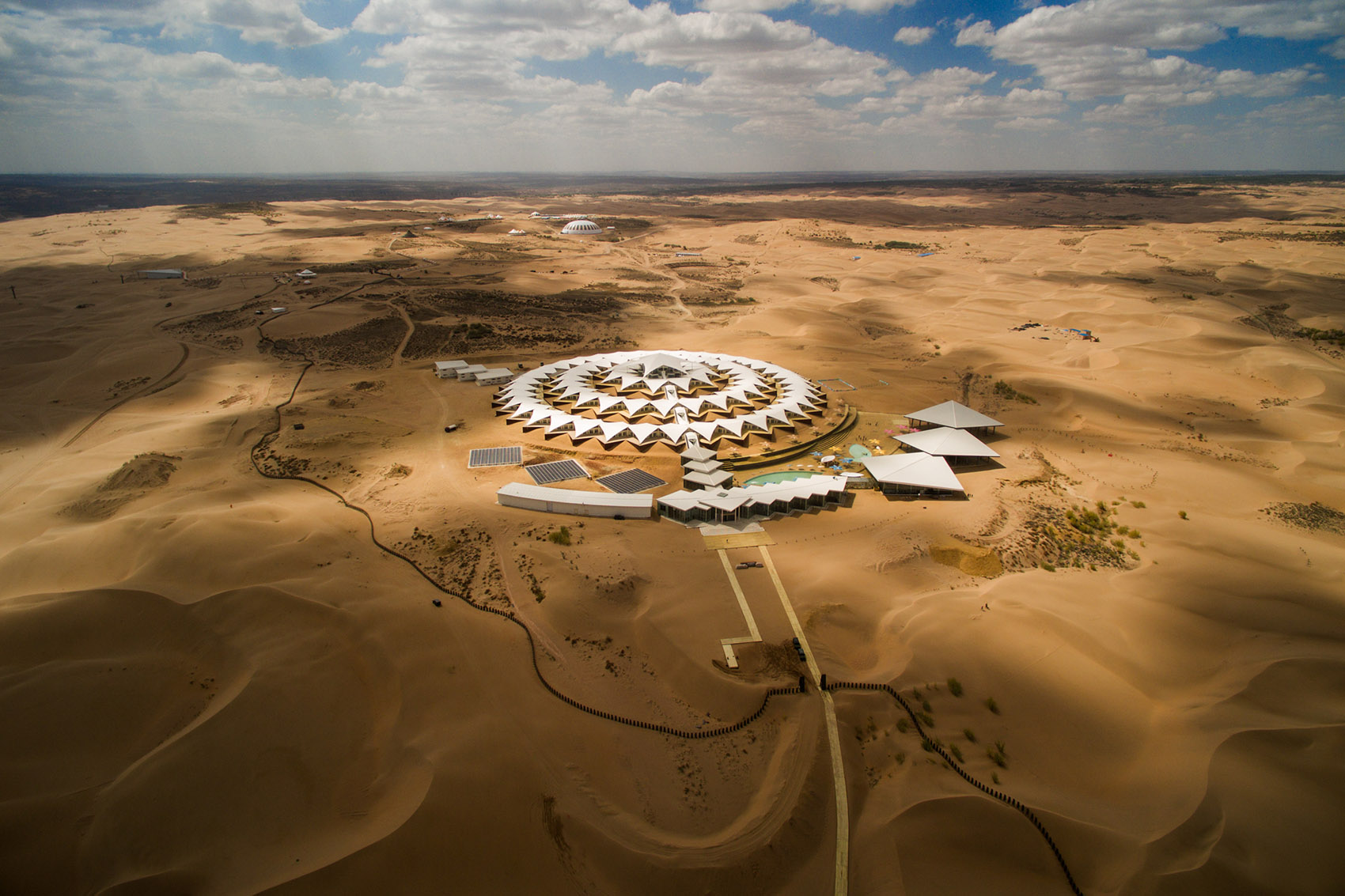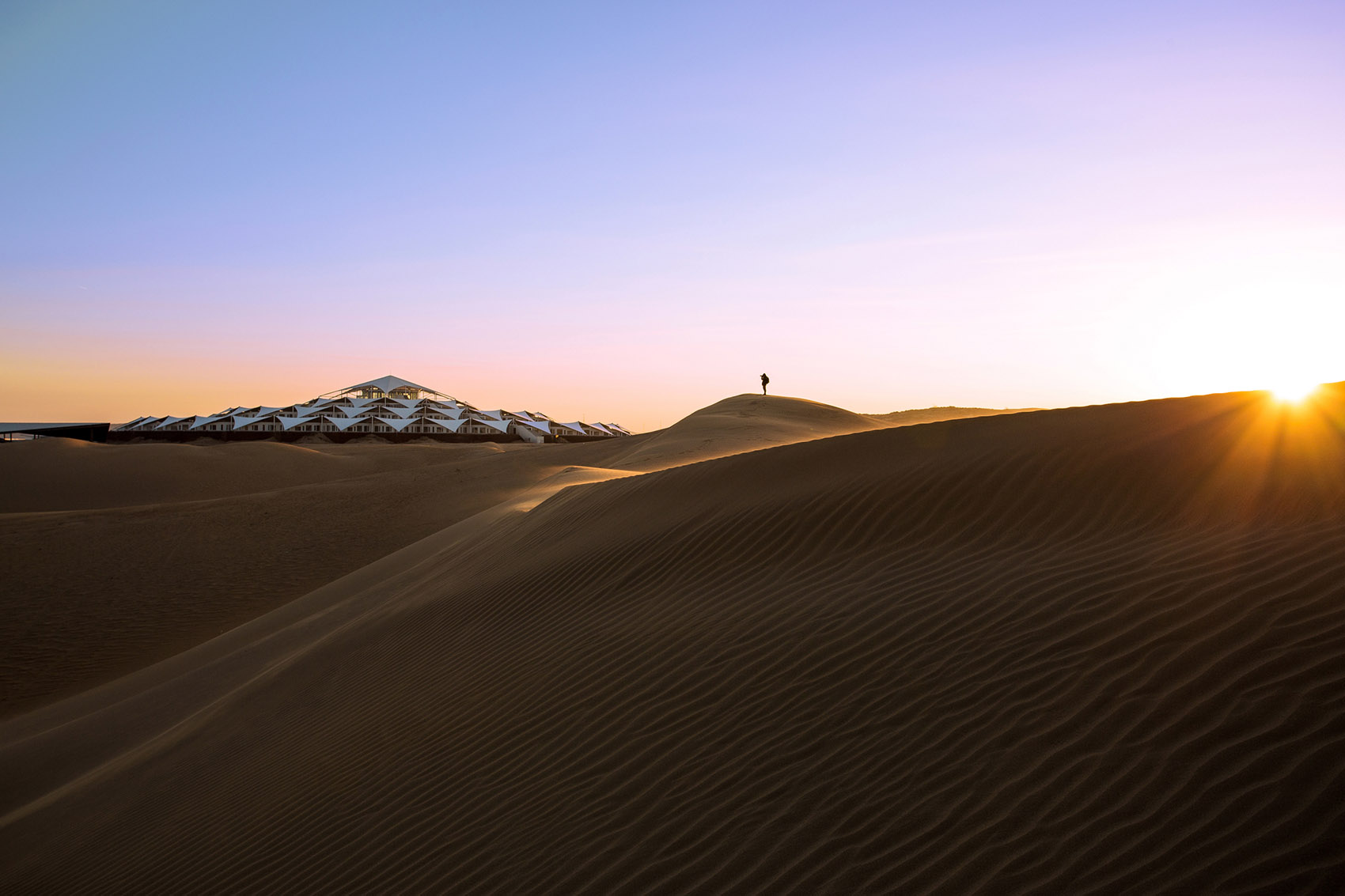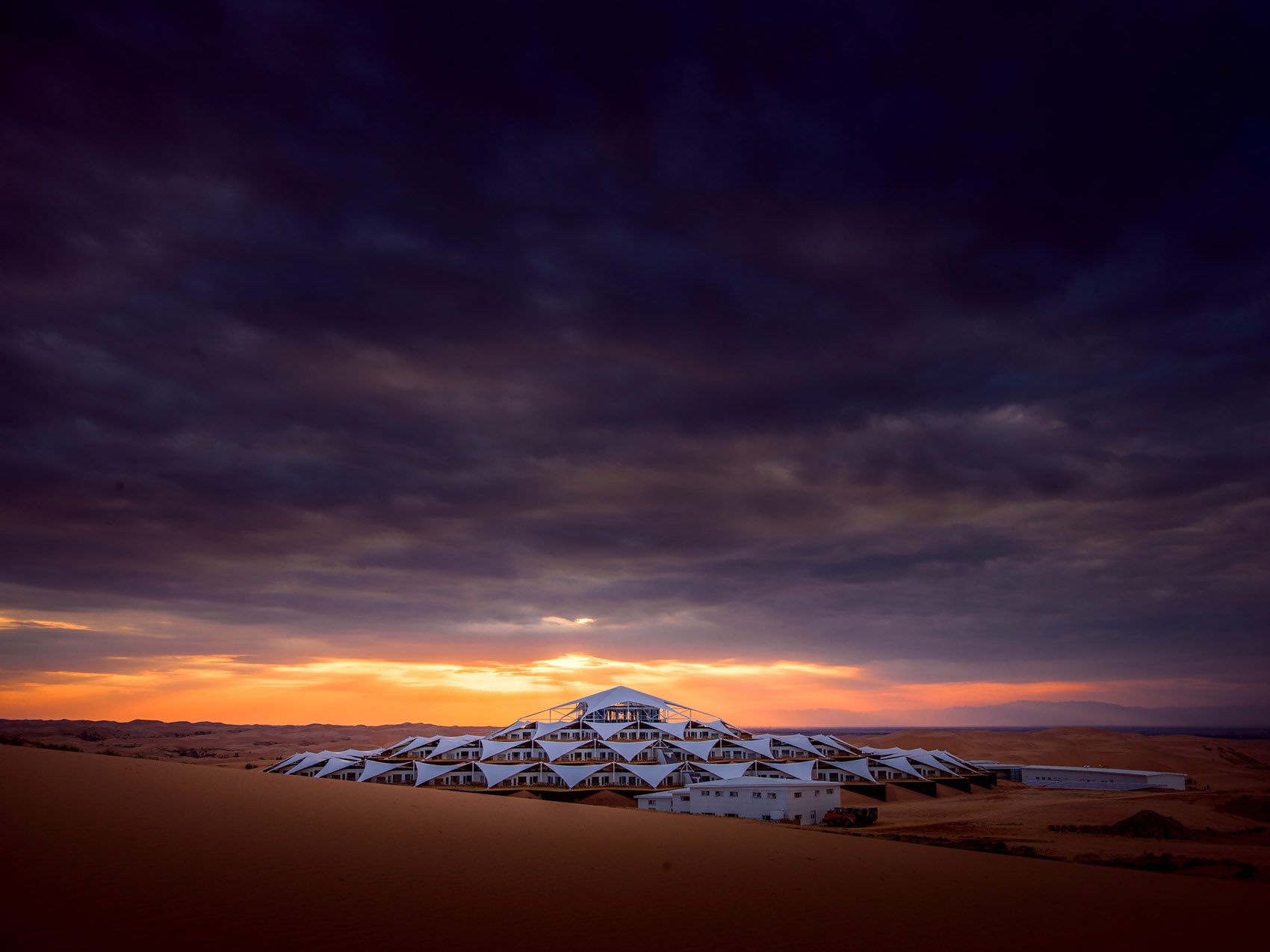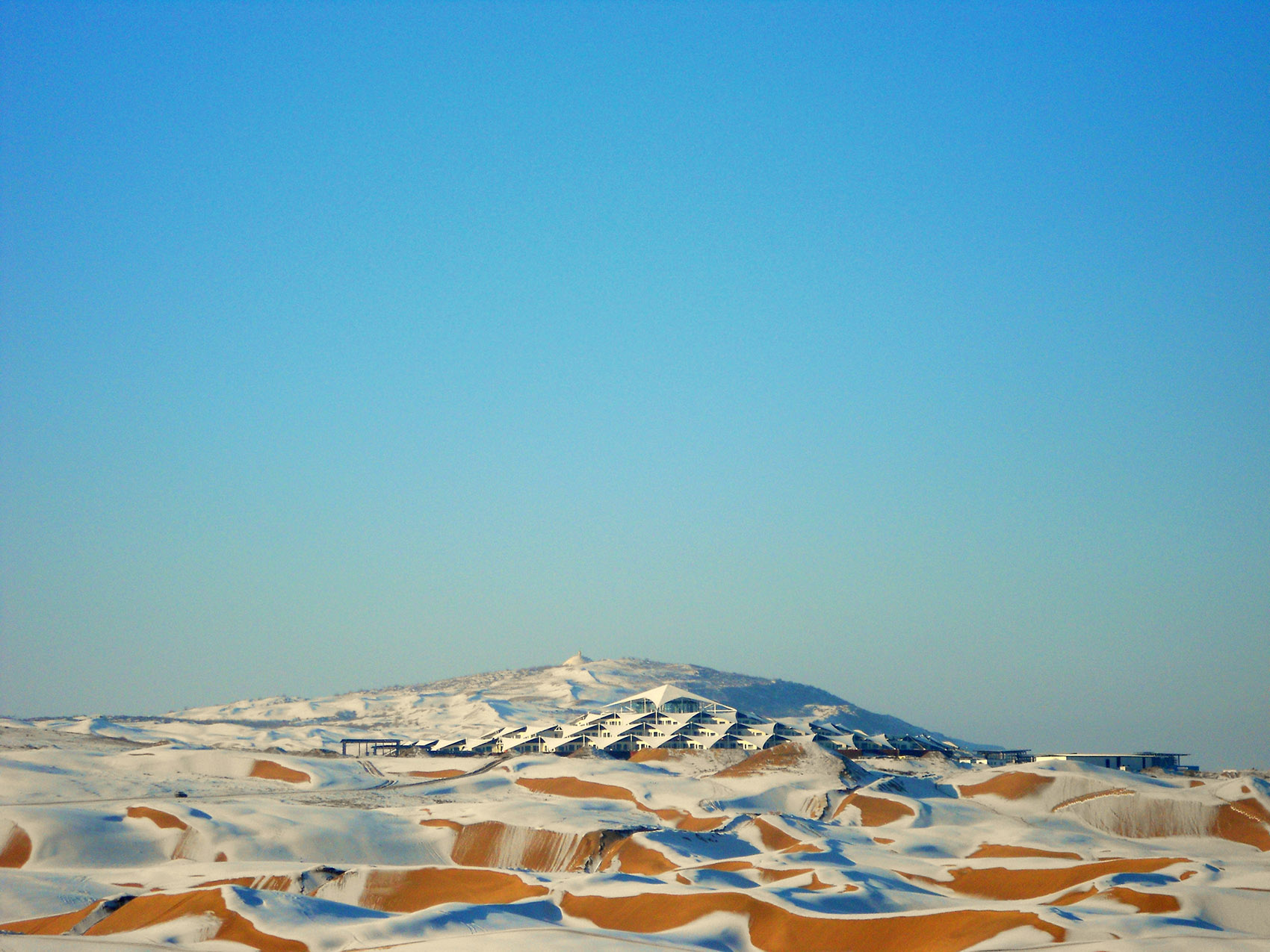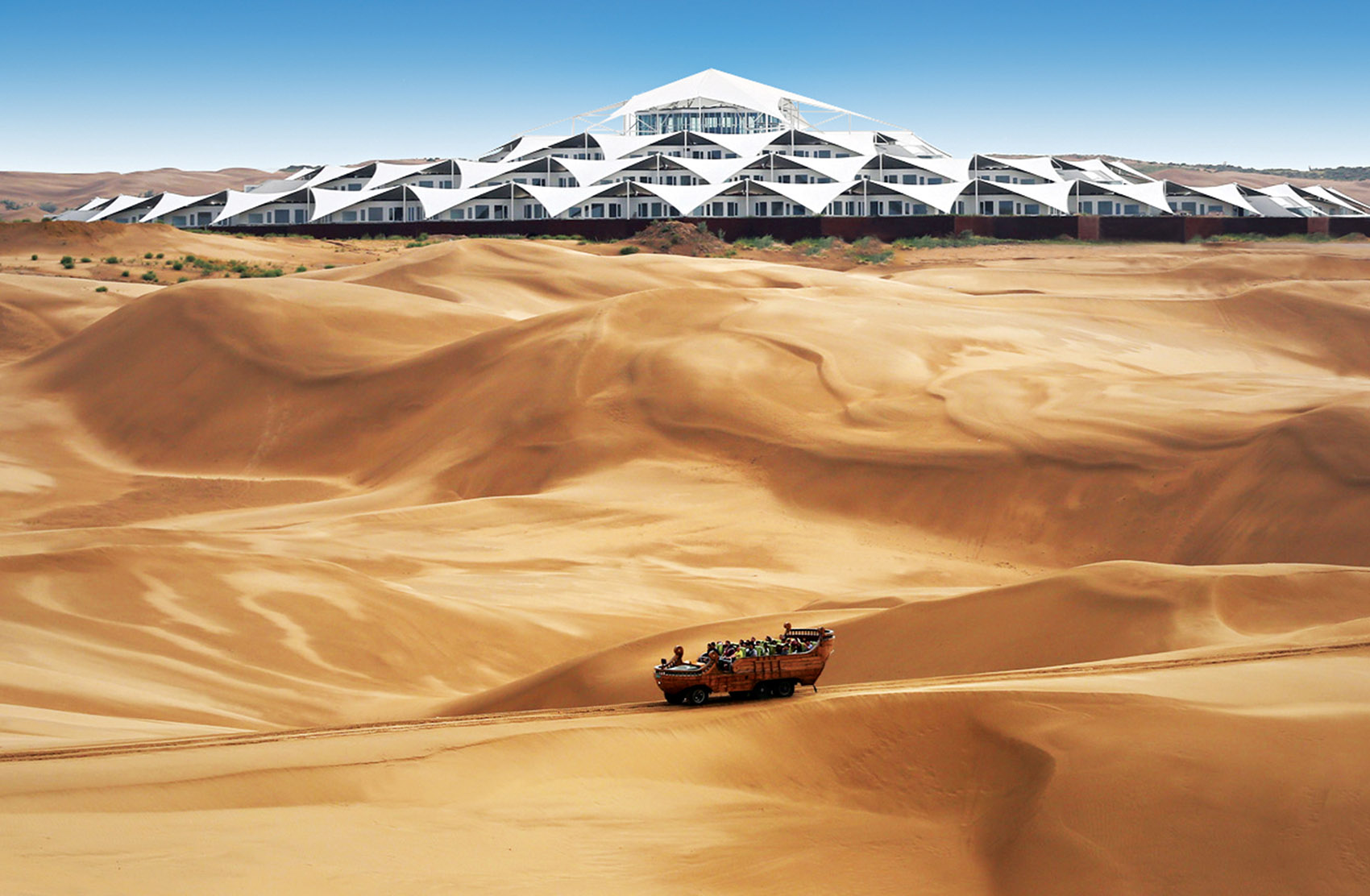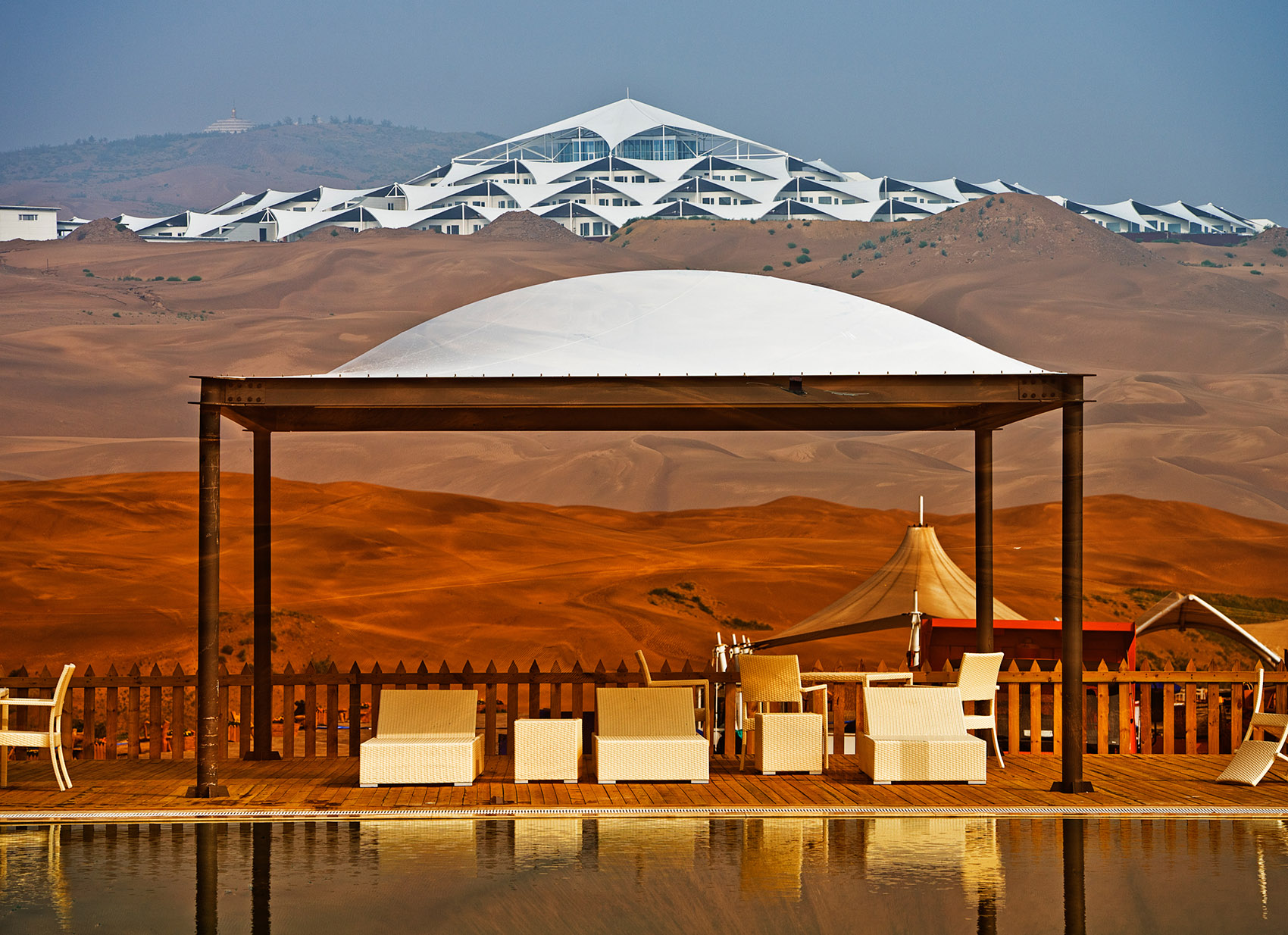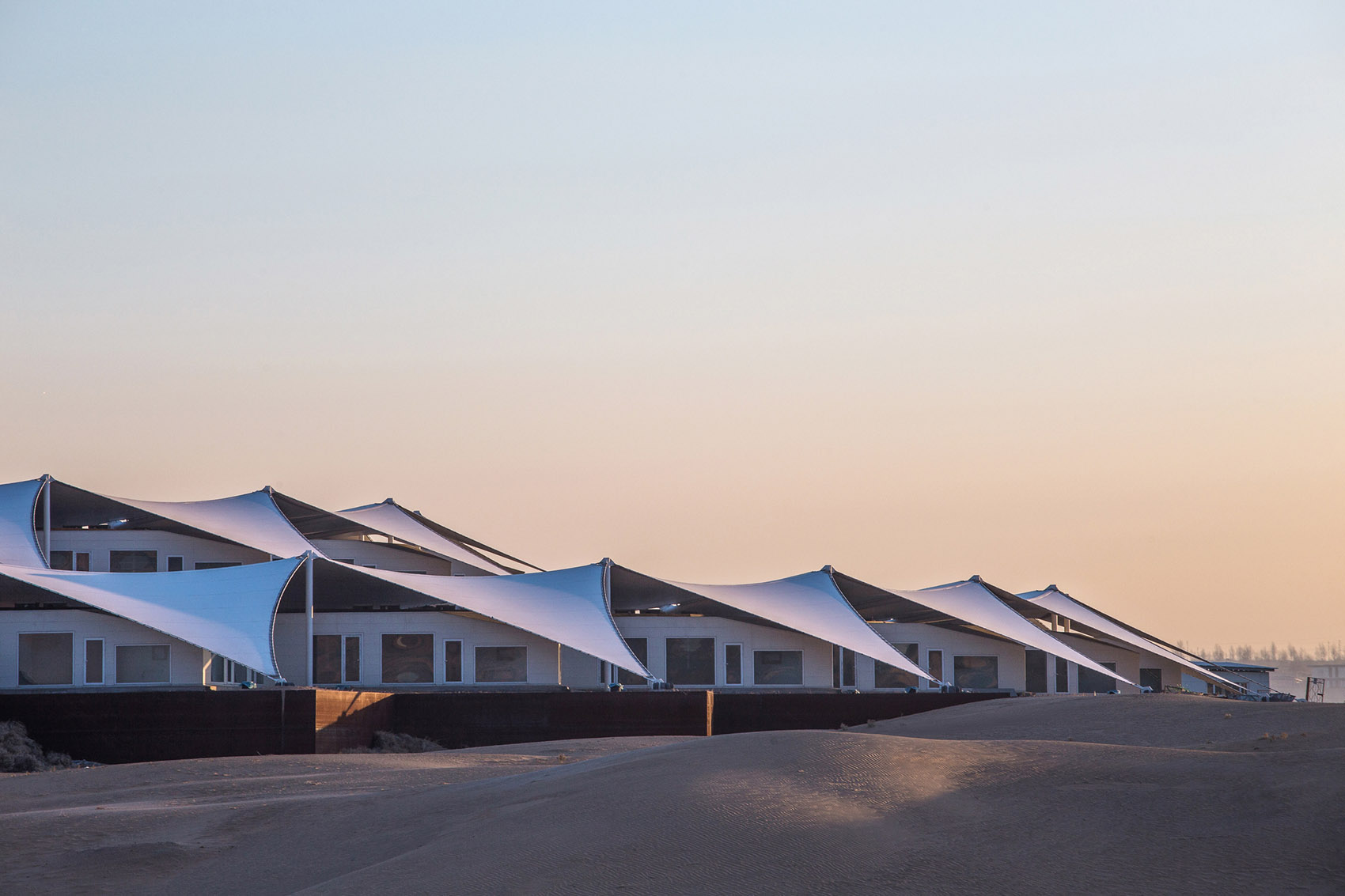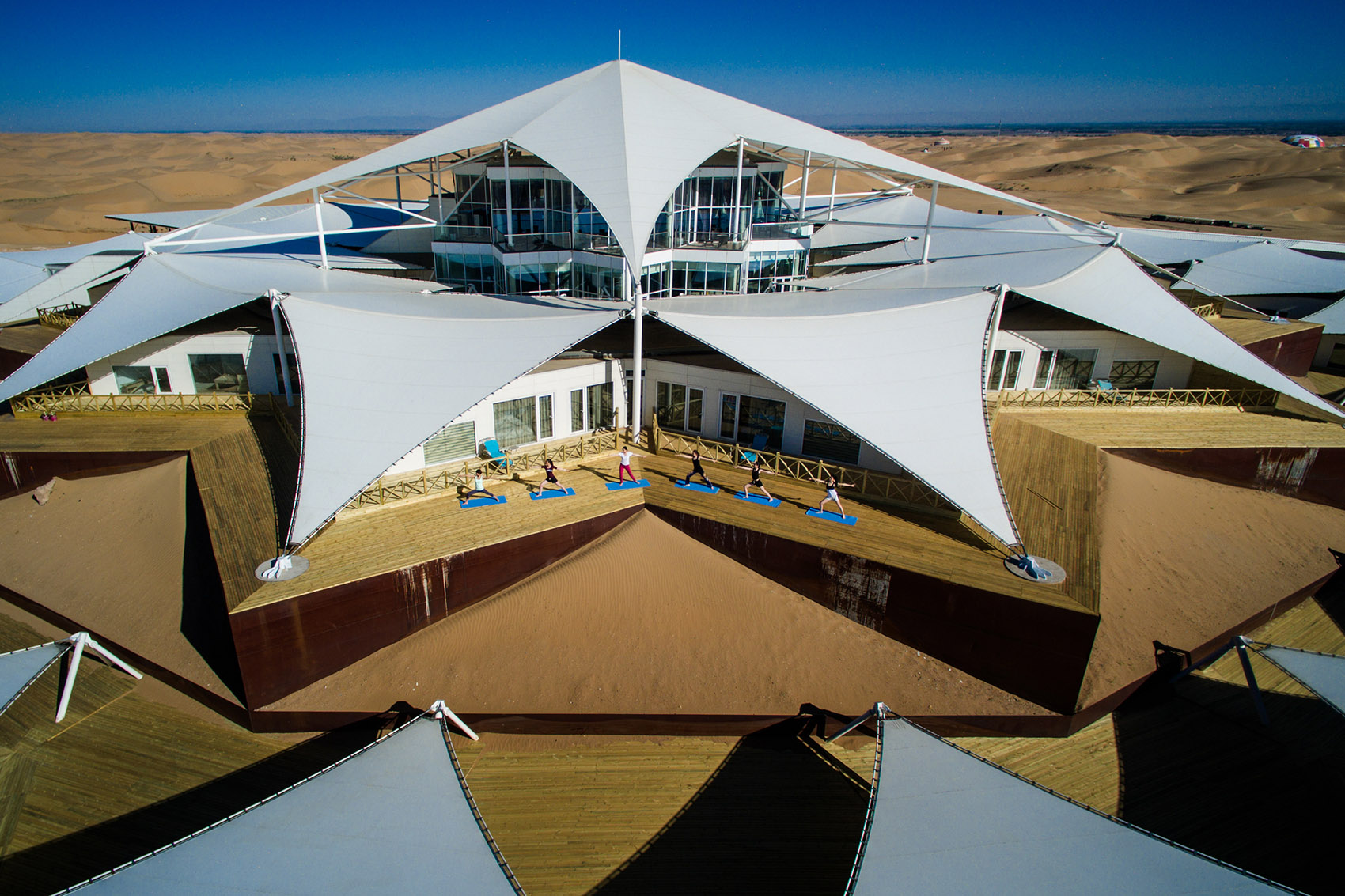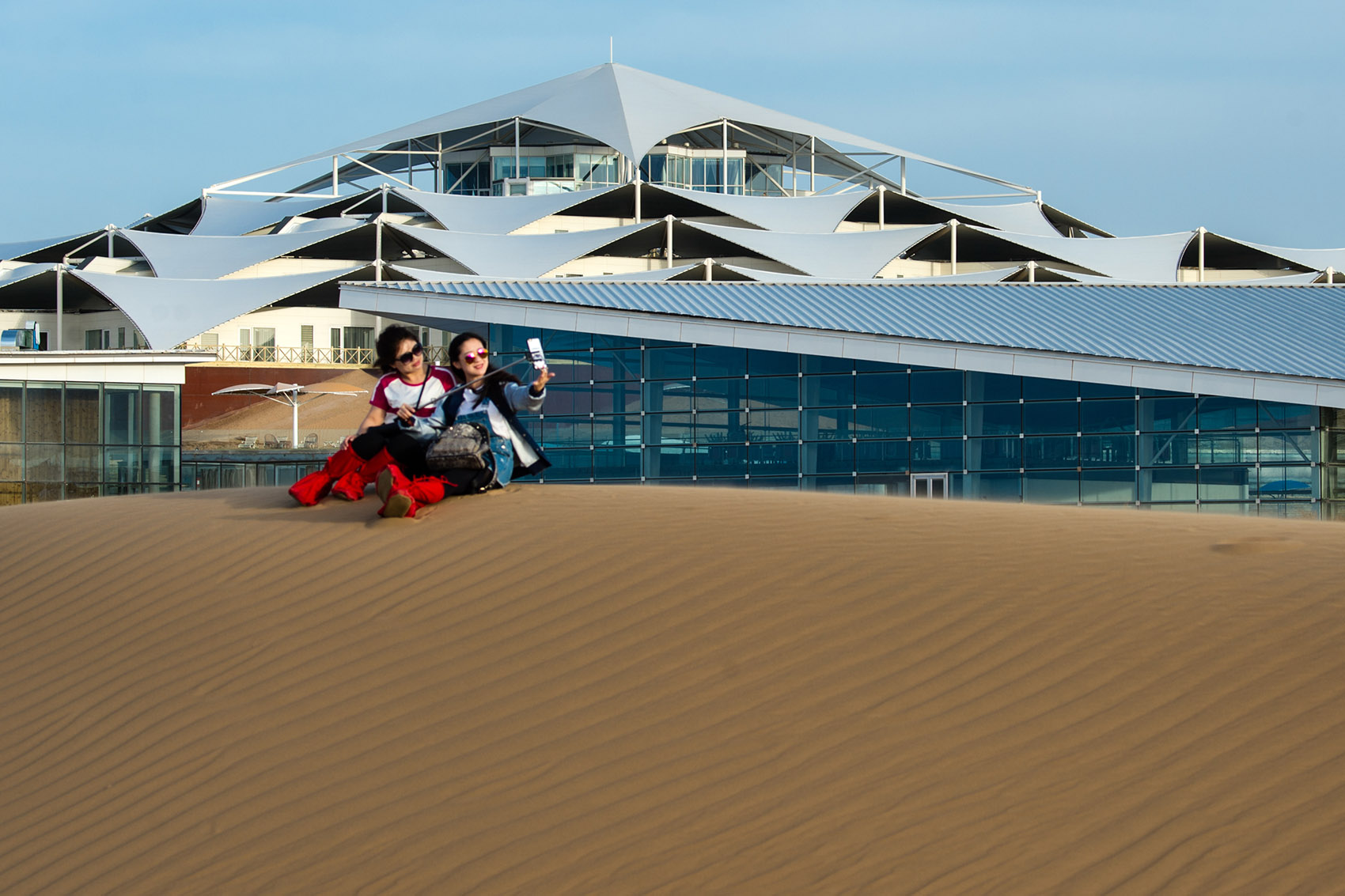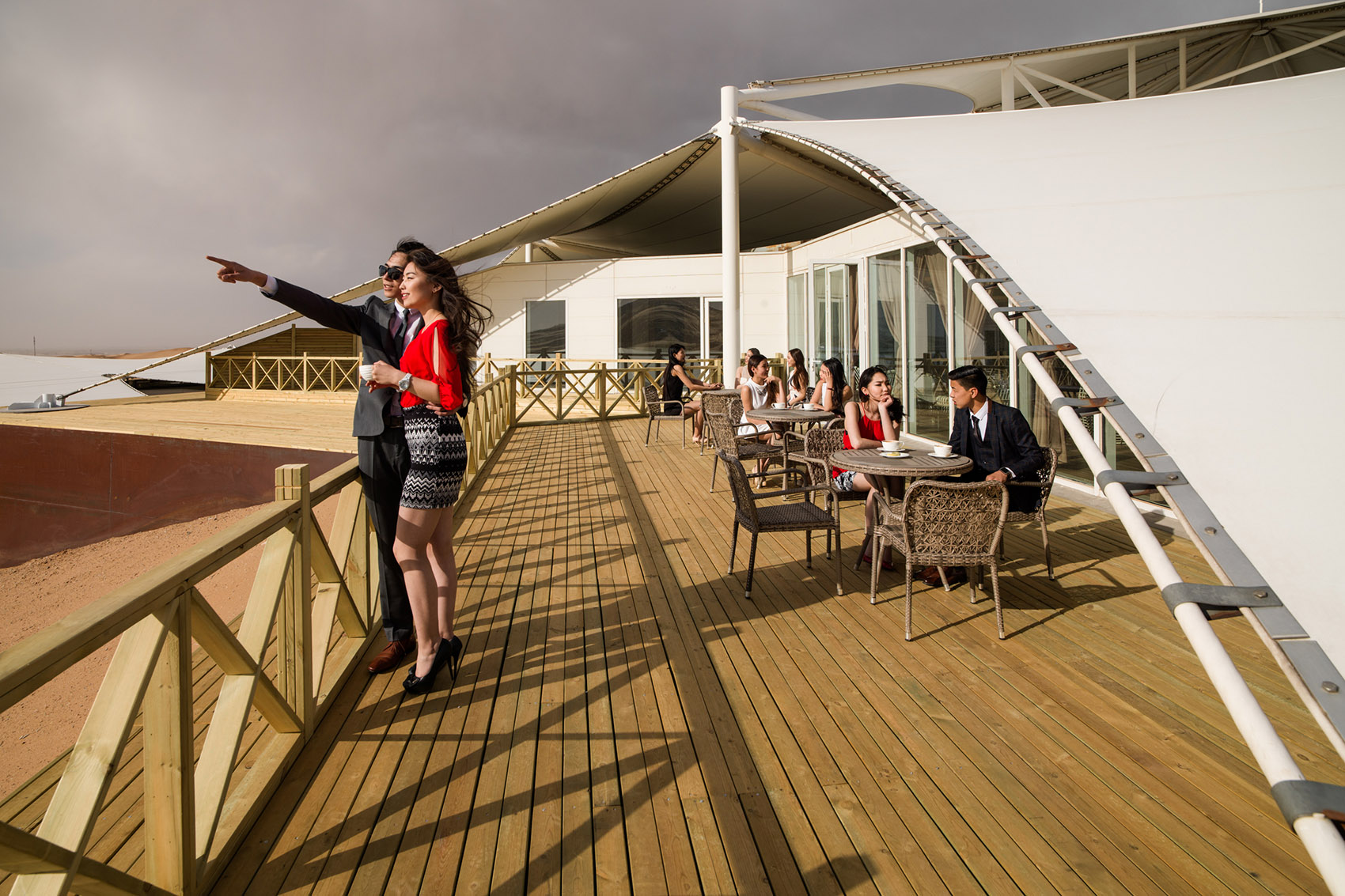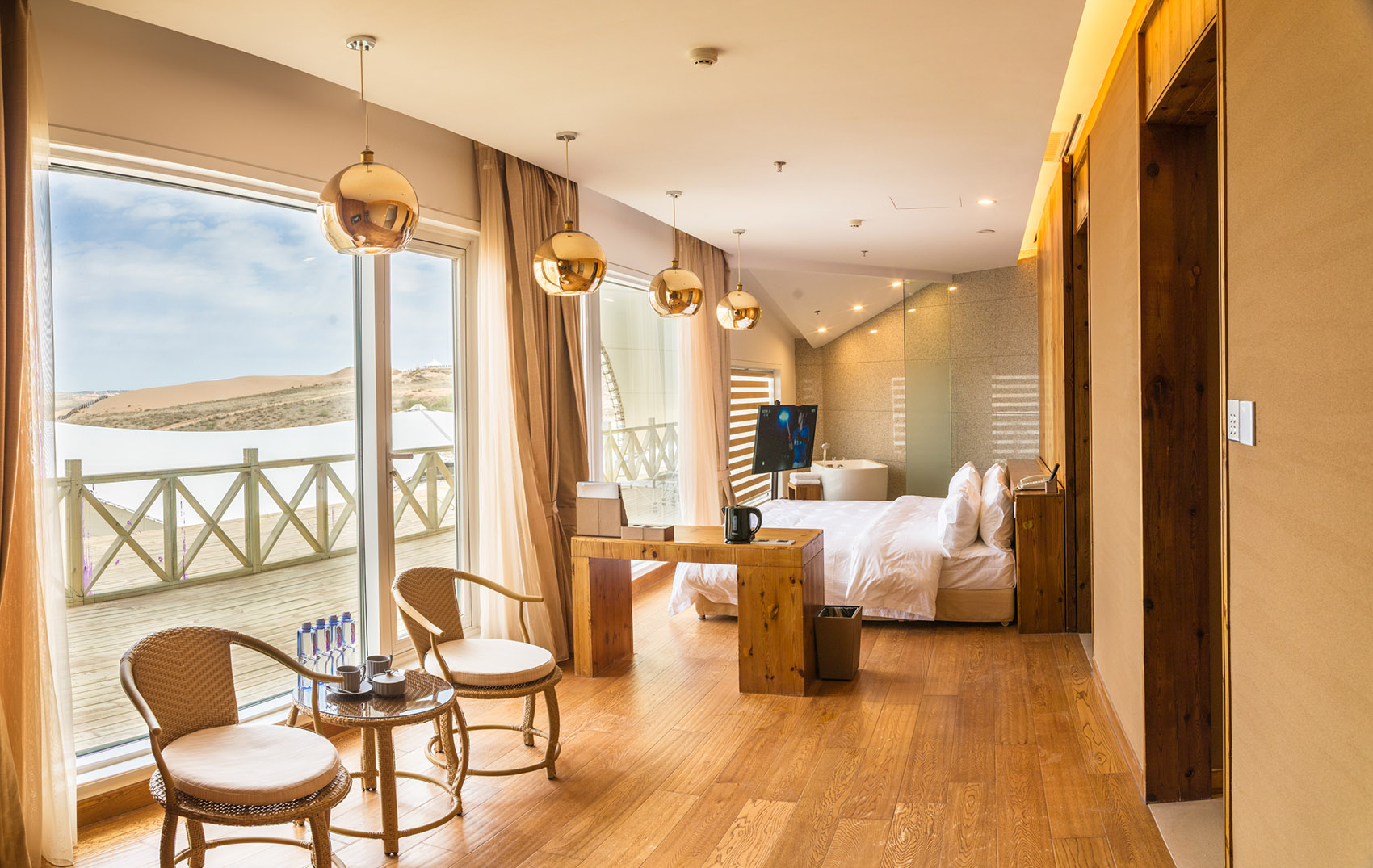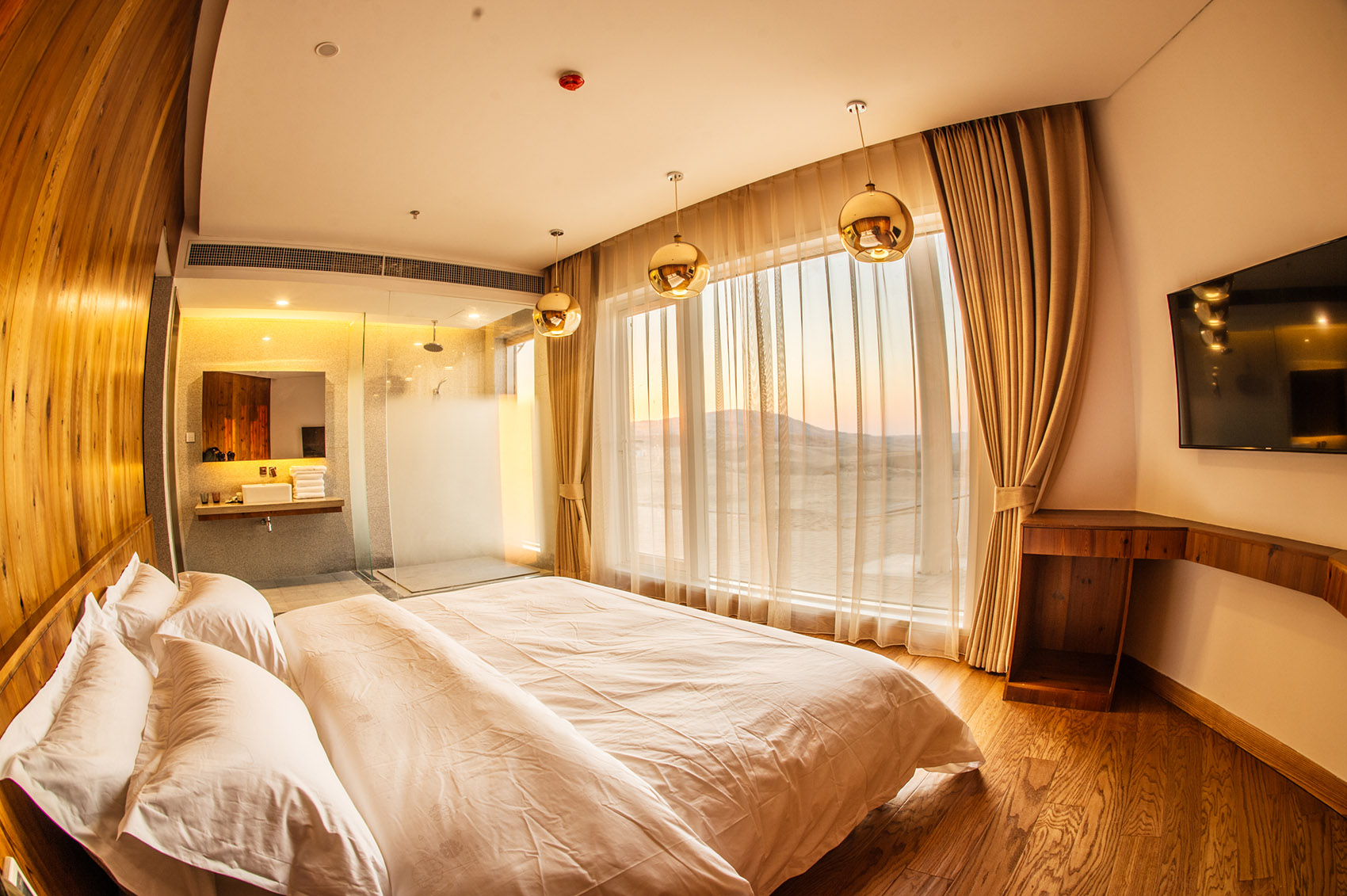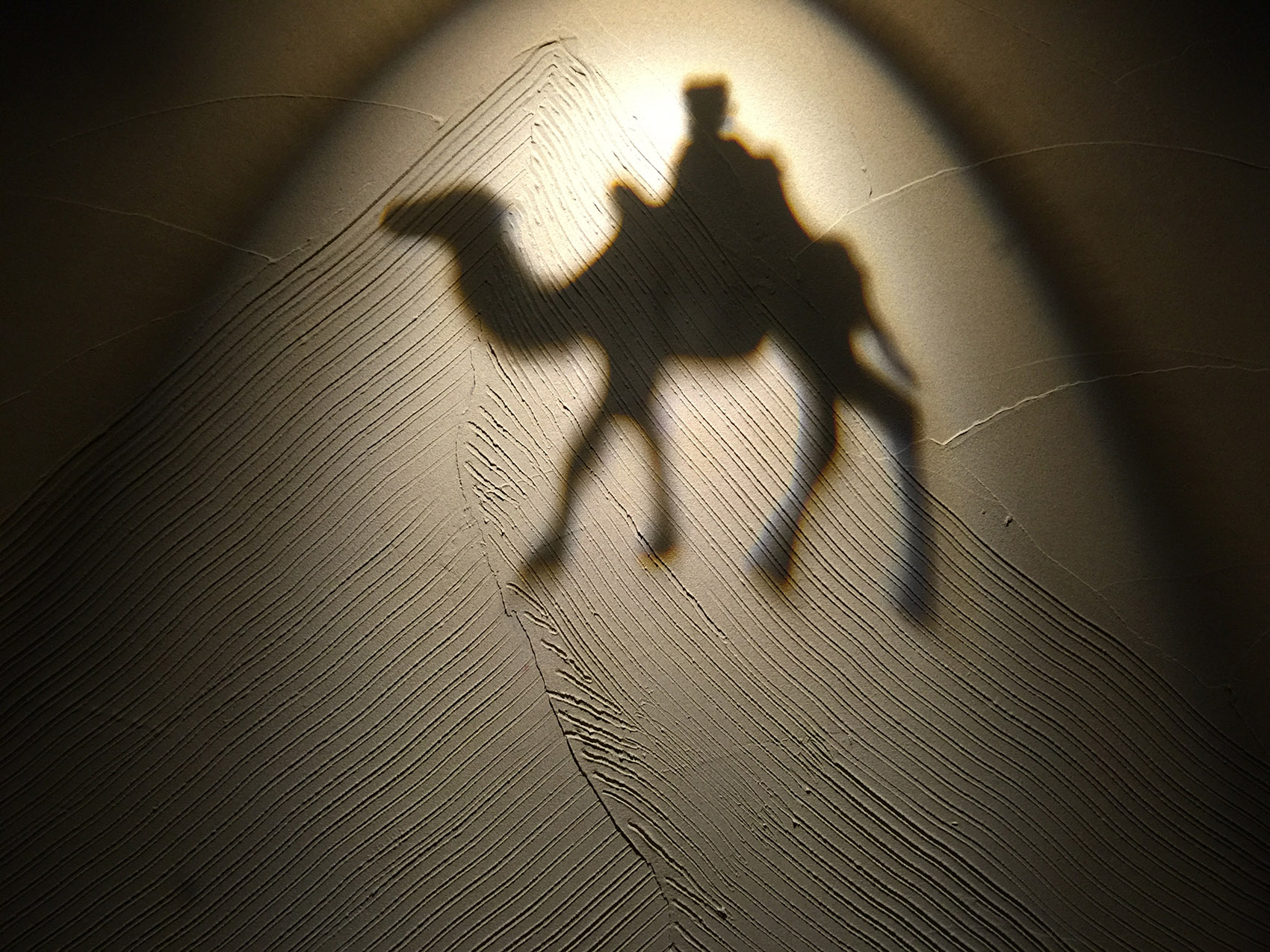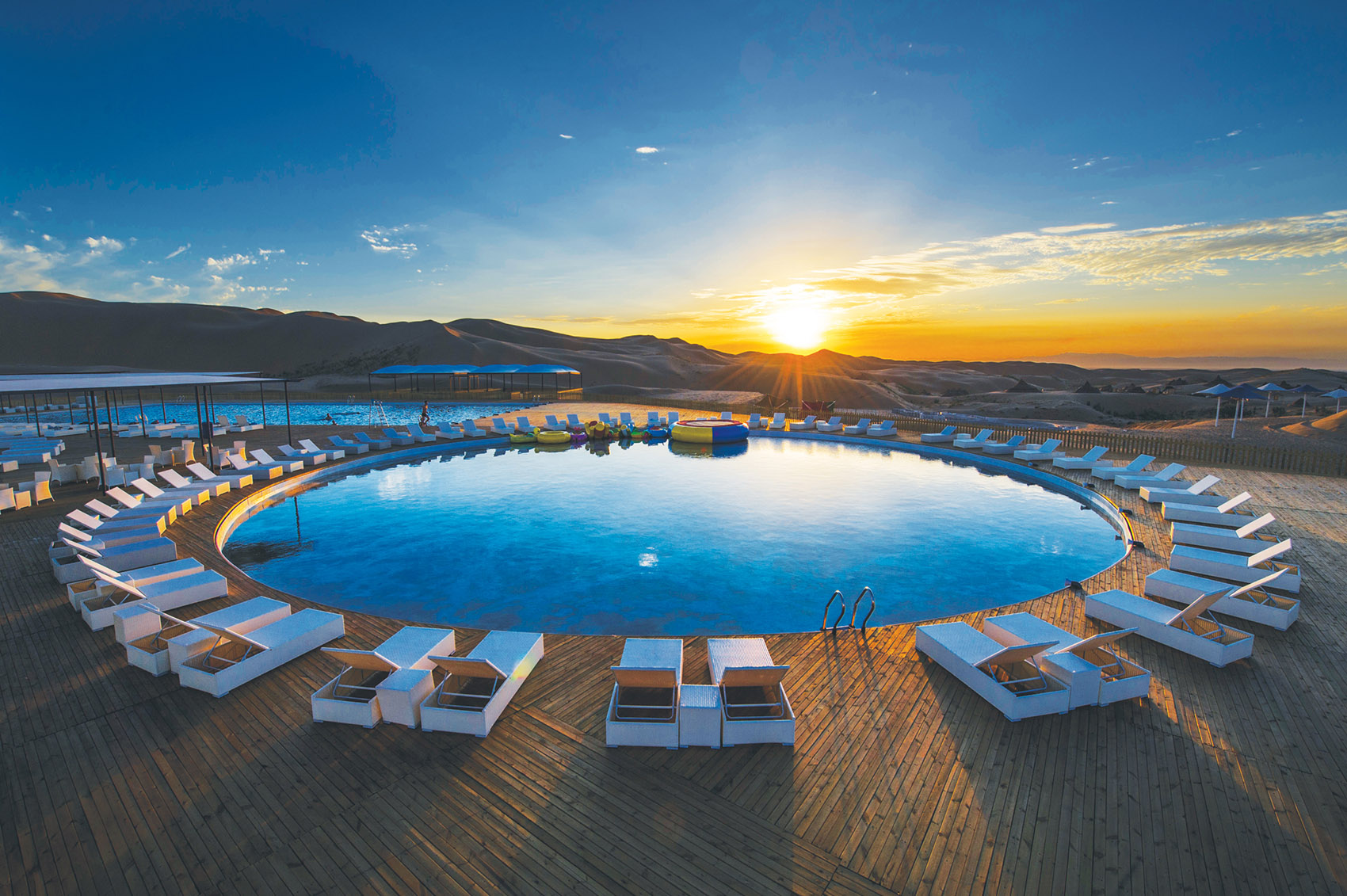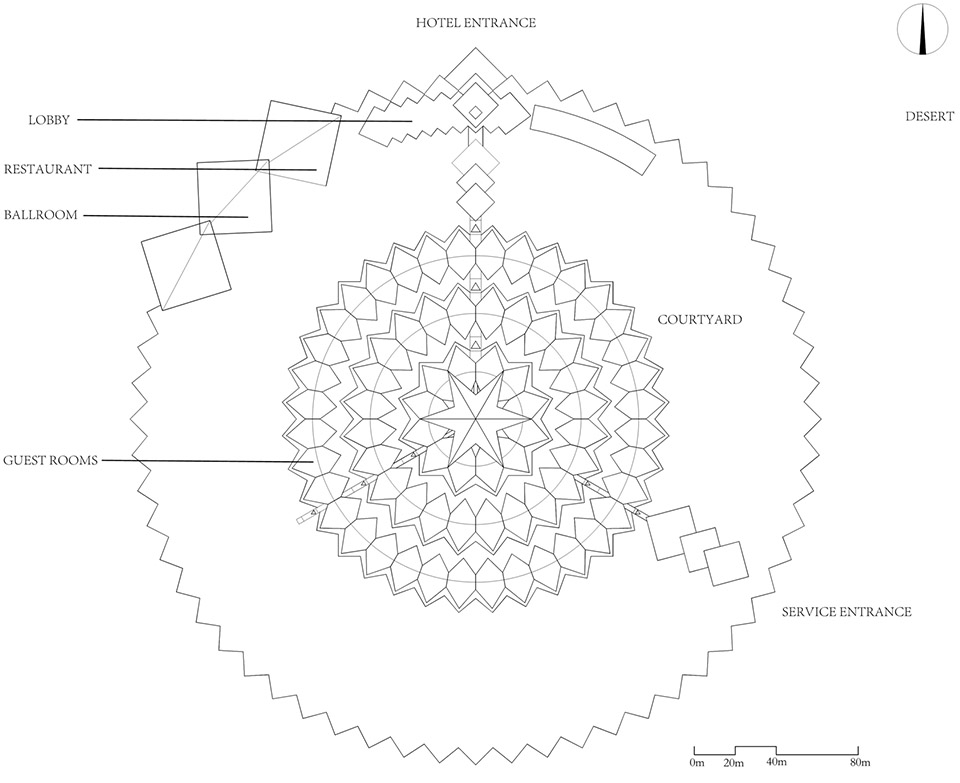莲花酒店位于中国内蒙古库布齐沙漠的响沙湾。
Lotus Resort is located in Xiangshawan Desert, a part of Kubuqi Desert, Inner Mongolia, China.
▼隐入沙脊线的莲花,the project embedded in the desert
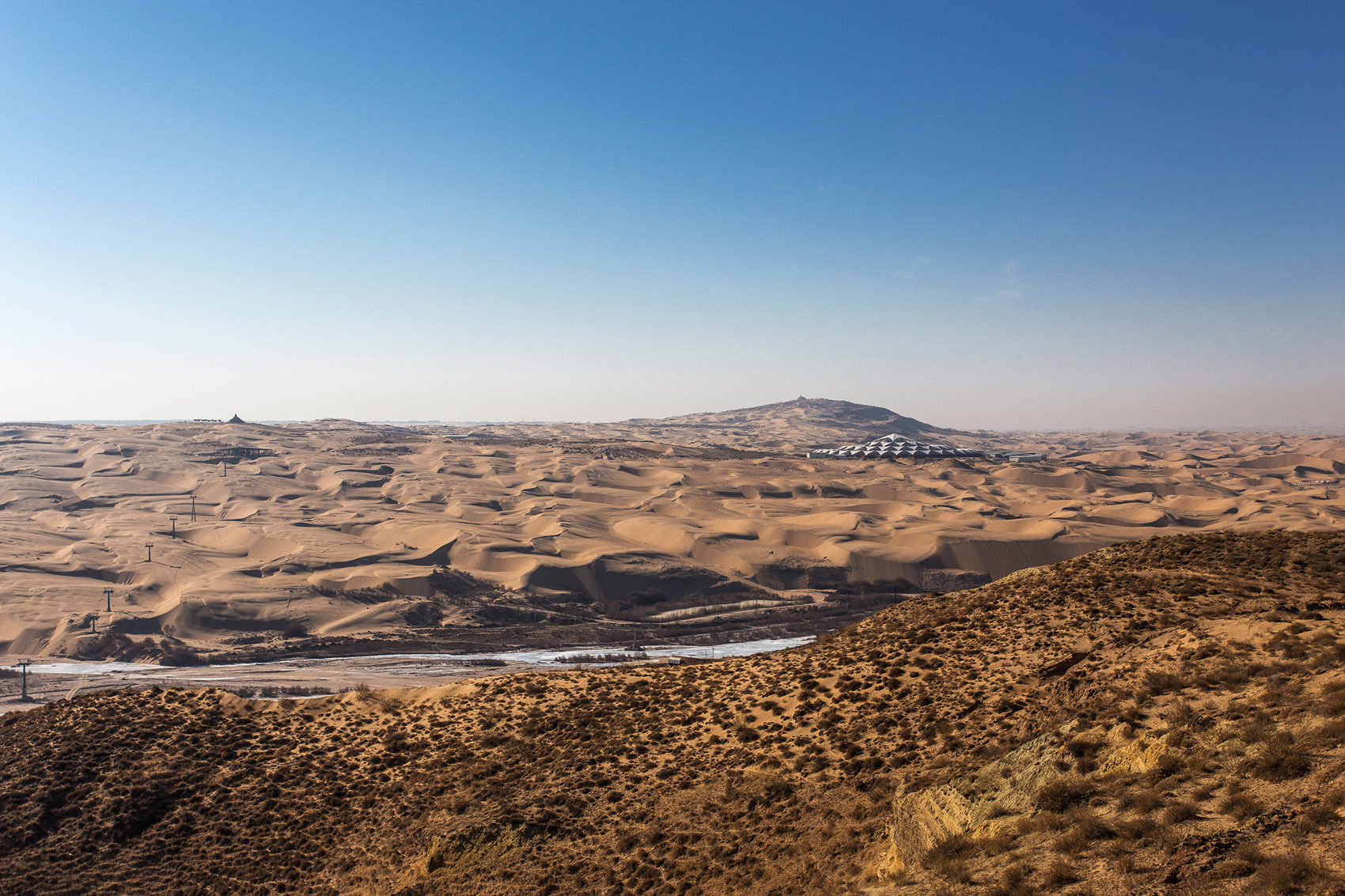
作为我们关键的结构生成理念,中国传统的“阵”的理念在设计中起到很大作用,“阵”通常指有序稳定的重复。莲花形式生成的逻辑源自简单等角度旋转的正方形,旋转的过程也形成了一系列三角形,这种简单几何体的旋转重复增强了建筑的力量感。考虑到结构,日照和风沙,我们集合了功能、形式和景观,生成了莲花的形状。莲花也深深植根于中国传统文化哲学的理念,在茫茫沙漠带给游客缱绻乡情。
As our core concept, the traditional Chinese philosophy of ‘Zhen’ has been celebrated in the design, which means replica of the identical. The logic of the form comes from simple rotations of squares, which would result in a delicate series of triangles that accentuate the visual appearance. In consideration of structure, shading and wind, we integrated function, form and landscape, resulting in a form of lotus. Additionally, lotus has been deeply rooted in Chinese aesthetic philosophy, which would gain the visitors a scent of nostalgia even in the barren desert.
▼酒店鸟瞰,aerial view
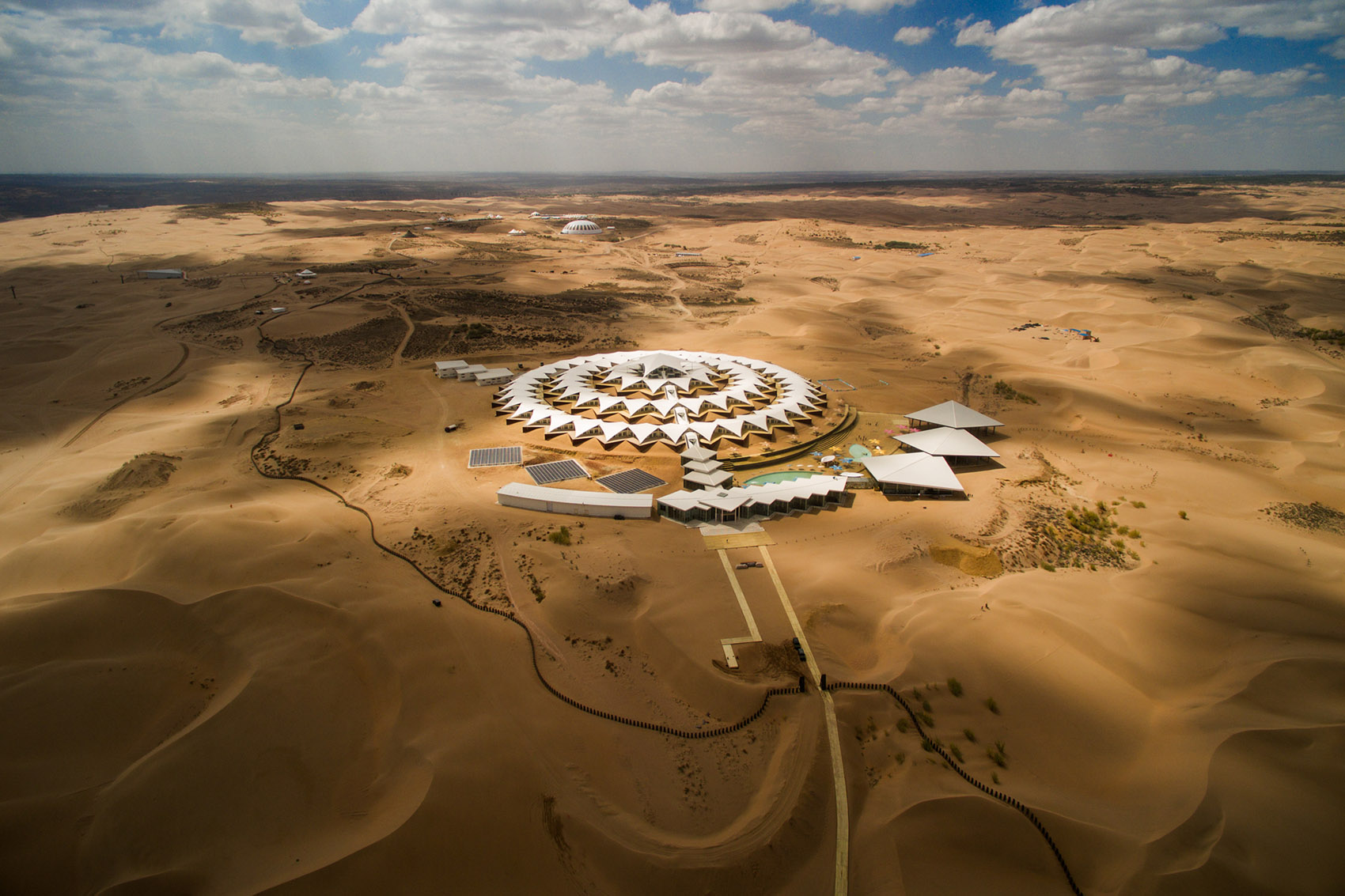
▼一系列三角形的旋转重复增强了建筑的力量感,a delicate series of triangles accentuate the visual appearance
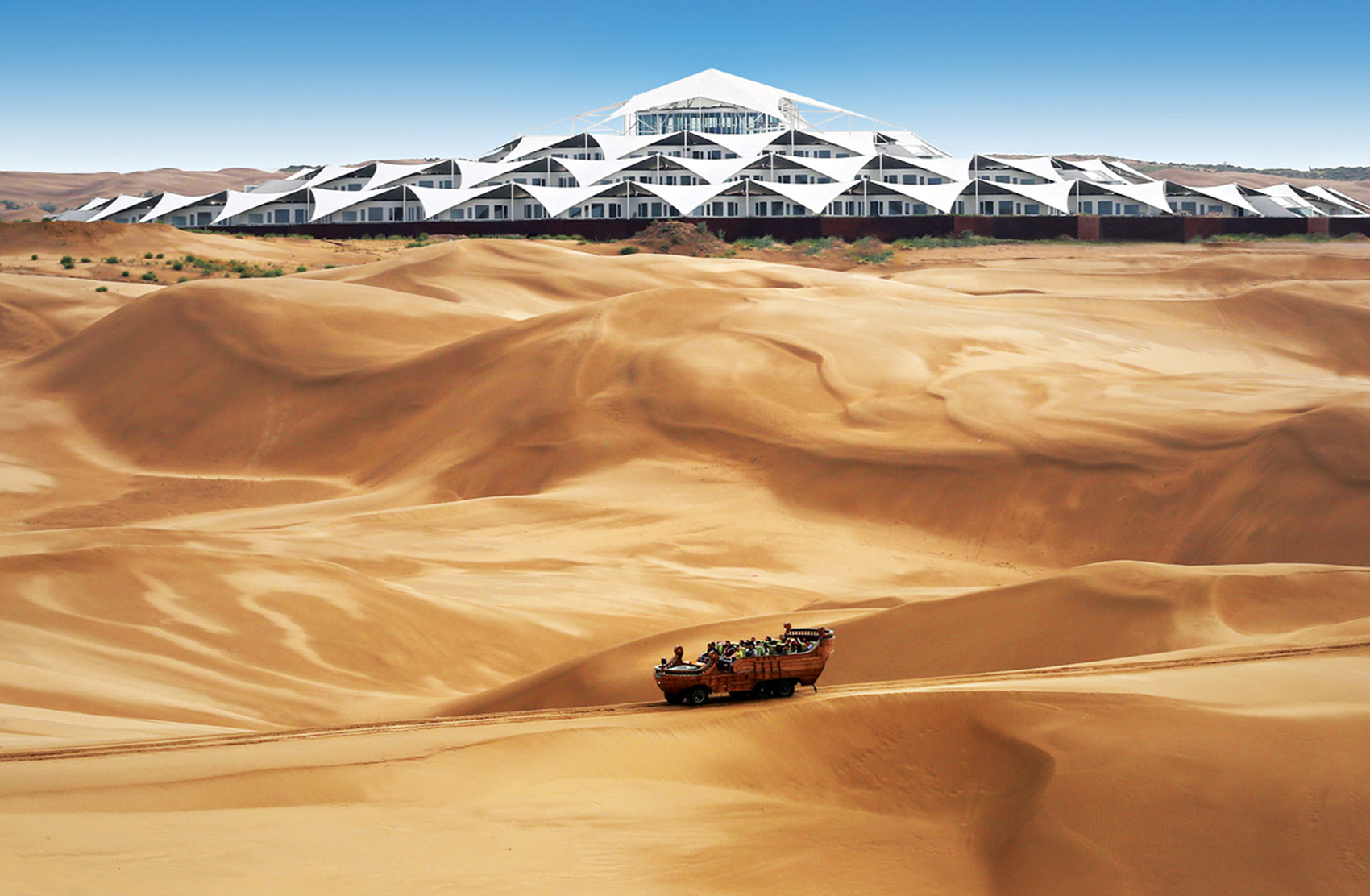
在空前的城市扩张形势下,我们讲目光转向在中国占有很大比例的地貌环境——沙漠,这很可能蕴藏着未来巨大的城市发展机遇和可能。我们设计了响沙湾莲花酒店,希望它不仅是能造福当代的绿洲,更是为了下一代创造一种沙漠利用的可能性和启发。莲花酒店是响沙湾沙漠城市计划的一部分。
With the unprecedented urban expansion, it would be reasonable to presume that desert, the most neglected portion of terrain in China, would probably bear the future opportunity of urban development. By designing the Xiangshawan Desert Lotus Hotel, we aim for not only an oasis that would be enjoyed by the current generation, but also the use of desert for urban expansion for generations to come. Lotus Resort is part of the Xiangshawan Desert development, which resides in Kubuqi Area.
▼雪景中的酒店,hotel in the snow-covered landscape
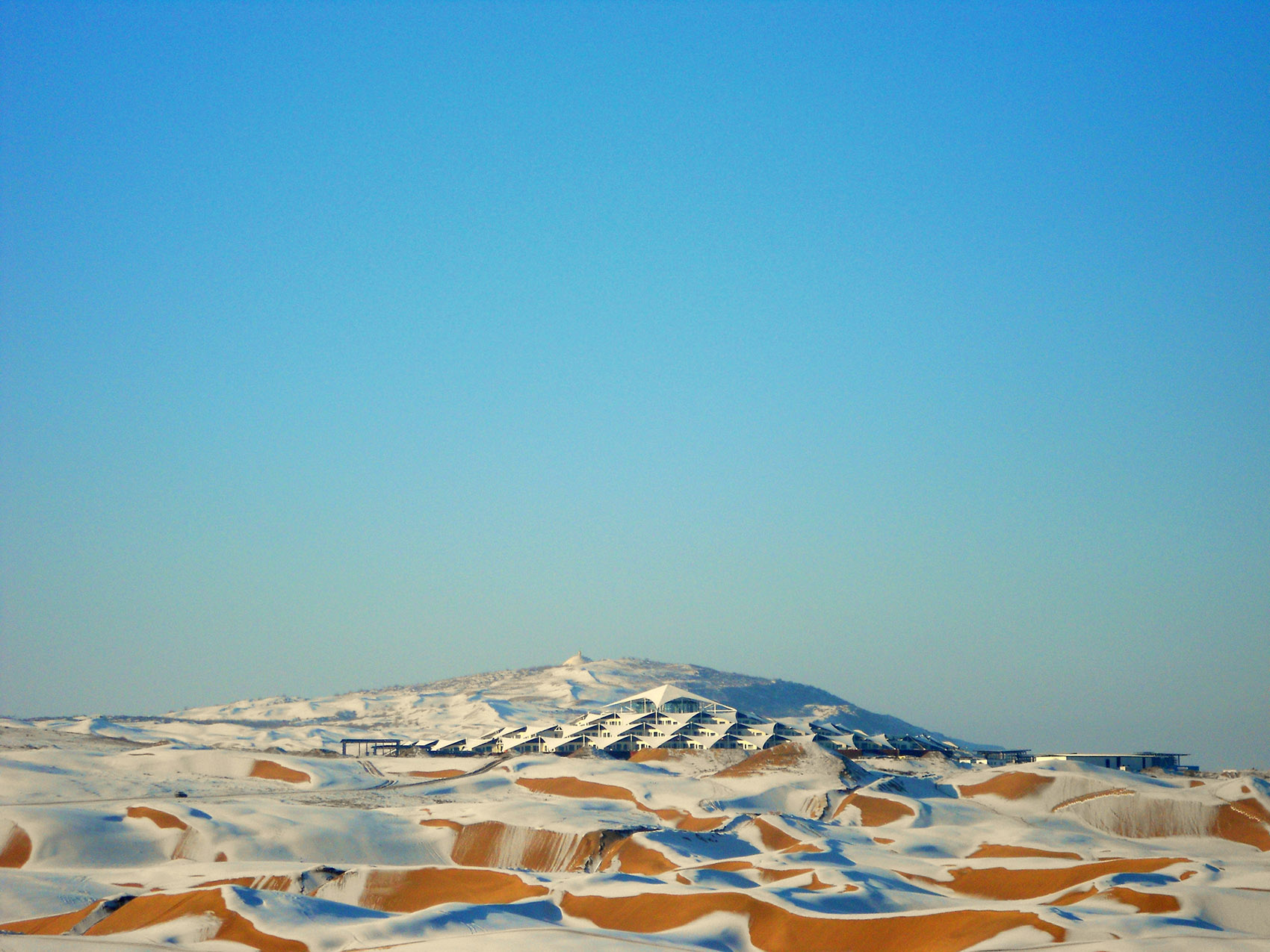
为了在沙漠中做出符合地质环境的建筑,我们研究出一个新的结构系统,以特定的钢板固定流沙,就像沙海浮舟一样的独特地基基础,基础在沙子均衡的作用力下保持平衡。同时,我们使用轻钢结构降低对基础的压力。
In order to make the design buildable in its special geographic context, we invented a new structural system that would be fixed in fluid sands by steel panels, which would function as a boat floating in the desert that carries the super-structure, while the sub-structure would be in relevant equilibrium due to the constant forces exerted by sands. Also, walls are load-bearing structures in order to reduce the pressure on base.
▼建筑以特定的钢板固定流沙,steel panels are used to fix the structure in fluid sands
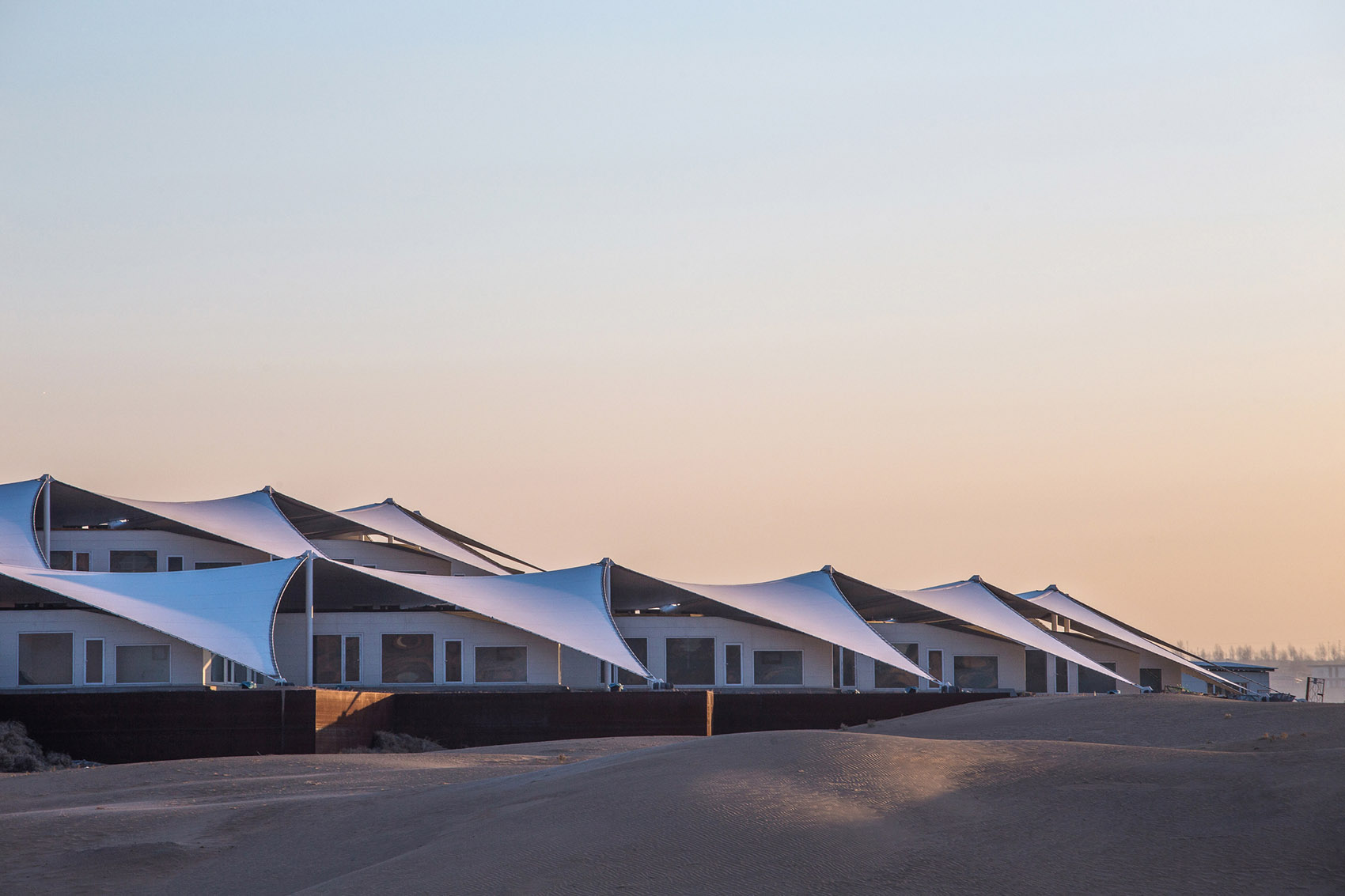
▼晚霞中的“沙海浮舟”,a “boat” floating in the desert
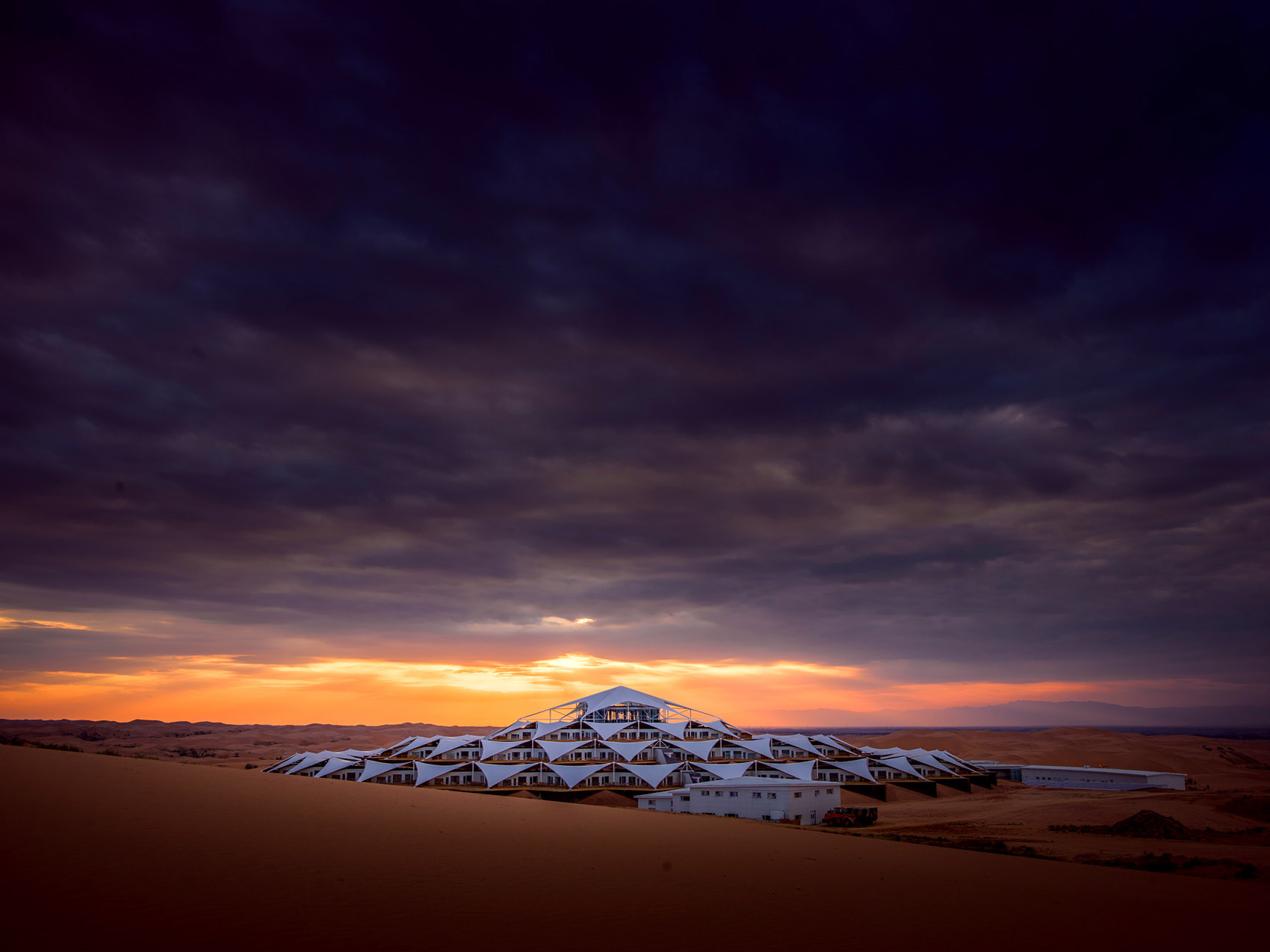
由于该地区建筑材料和有经验的工人的匮乏,我们特殊定制了当地广泛使用的一种砂做装饰材料,这不仅降低了投入,更减少了项目中的碳排放,以及未来持续的耗费,因为这给当地沙子资源的再利用以可能。
Due to the drastic lack of finish materials and skilled workers in the area, we customized a new kind of finish material from sands, which pervade in the local context for the project. This not only reduced the capital investment and carbon footprint in the project, but future maintenance cost as well, since it would be possible for the local to reproduce the finish material.
▼以膜结构覆盖的屋顶平台,roof terrace covered with membrane
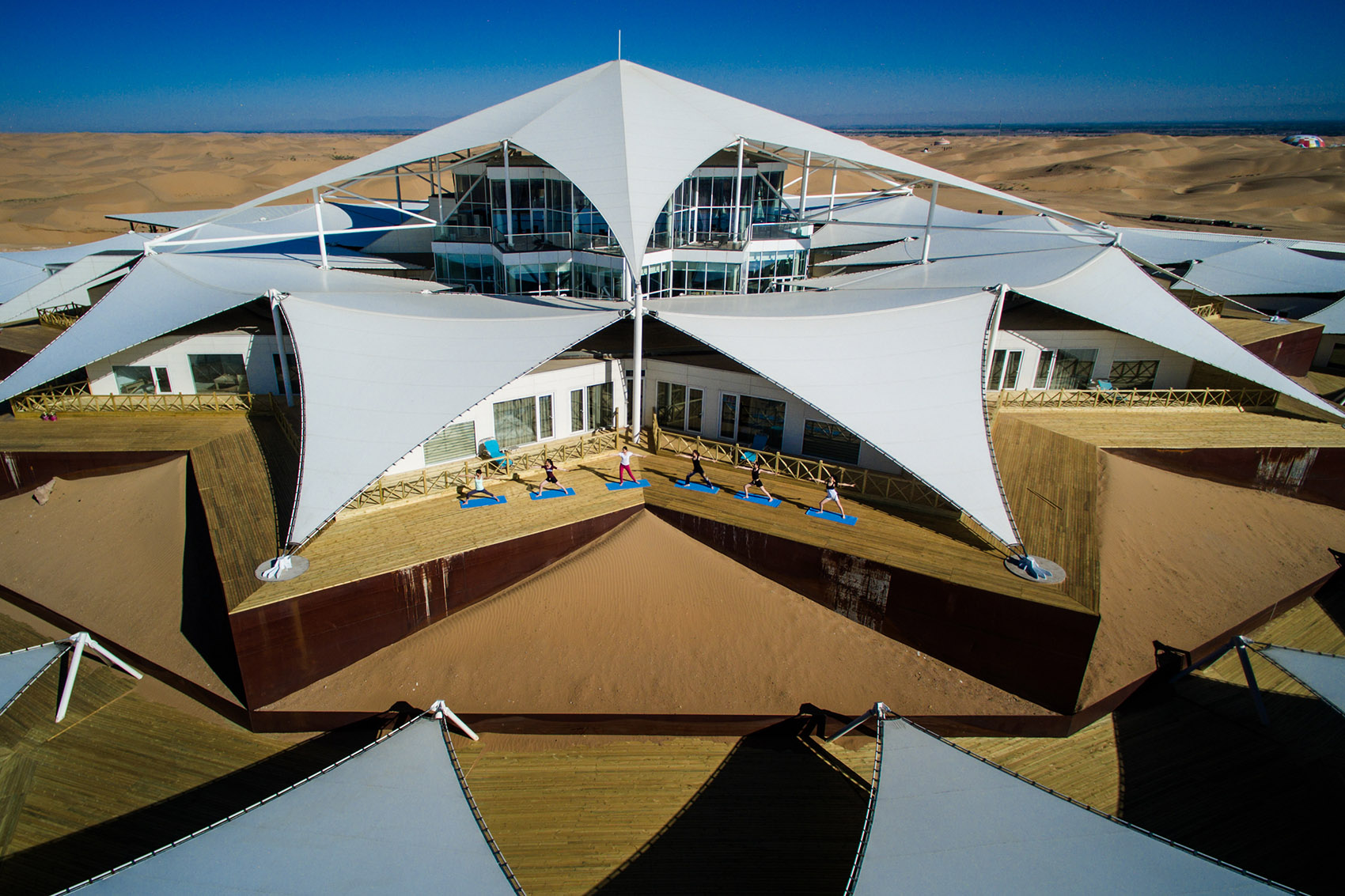
酒店总面积达30700㎡,但不会产生想象中的温室气体排放。代替了高科技设备,比如光伏管、太阳能电池等,我们用最原始的方式降低碳排放。比如,膜结构不仅是一种视觉景观,更承担着室内遮阳的作用,预估在冷却系统上能降低碳排放及电能的消耗。通过类似的手法,建筑对比使用科技手段带来的舒适性拥有更低能耗。莲花的形式源自浩瀚沙漠中沙丘的形式,同时考虑到沙漠化,日晒,风荷载及雨水收集的相关因素。
With a total area of 30700㎡, the hotel would not create as much carbon footprint as imagined. Instead of utilizing high-tech equipment such photovoltaic panels and solar batteries, we seek the most primitive methods of reducing carbon emission. For instance, the membrane is not only an eye-catching element, but also a passive design strategy to reduce solar gain for the interior, which has considerably reduced the carbon-footprints and electricity costs incurred by mechanical cooling systems. By using similar strategies, the building would become less vulnerable compared to buildings that are equipped with too much high-tech. Also, the form of lotus is a logical result from the purpose of sand stabilization, sun-shading, wind-load bearing and rainwater collection.
▼从水池区域望向酒店,view to the hotel from the pool area
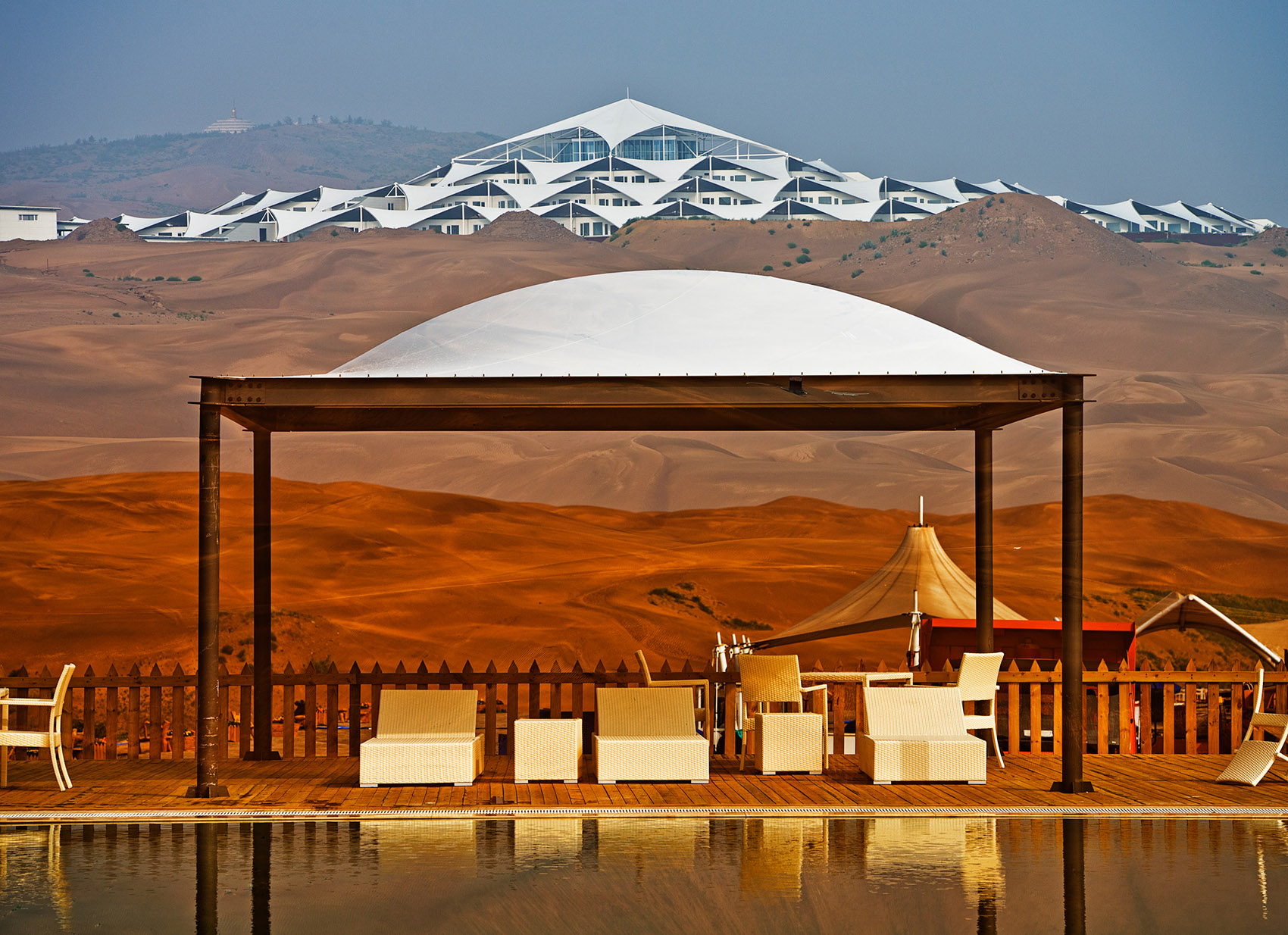
▼配套水池设施,hotel pool and facilities

▼莲花的形式源自浩瀚沙漠中沙丘的形式,the form of lotus is a logical result from the purpose of sand stabilization
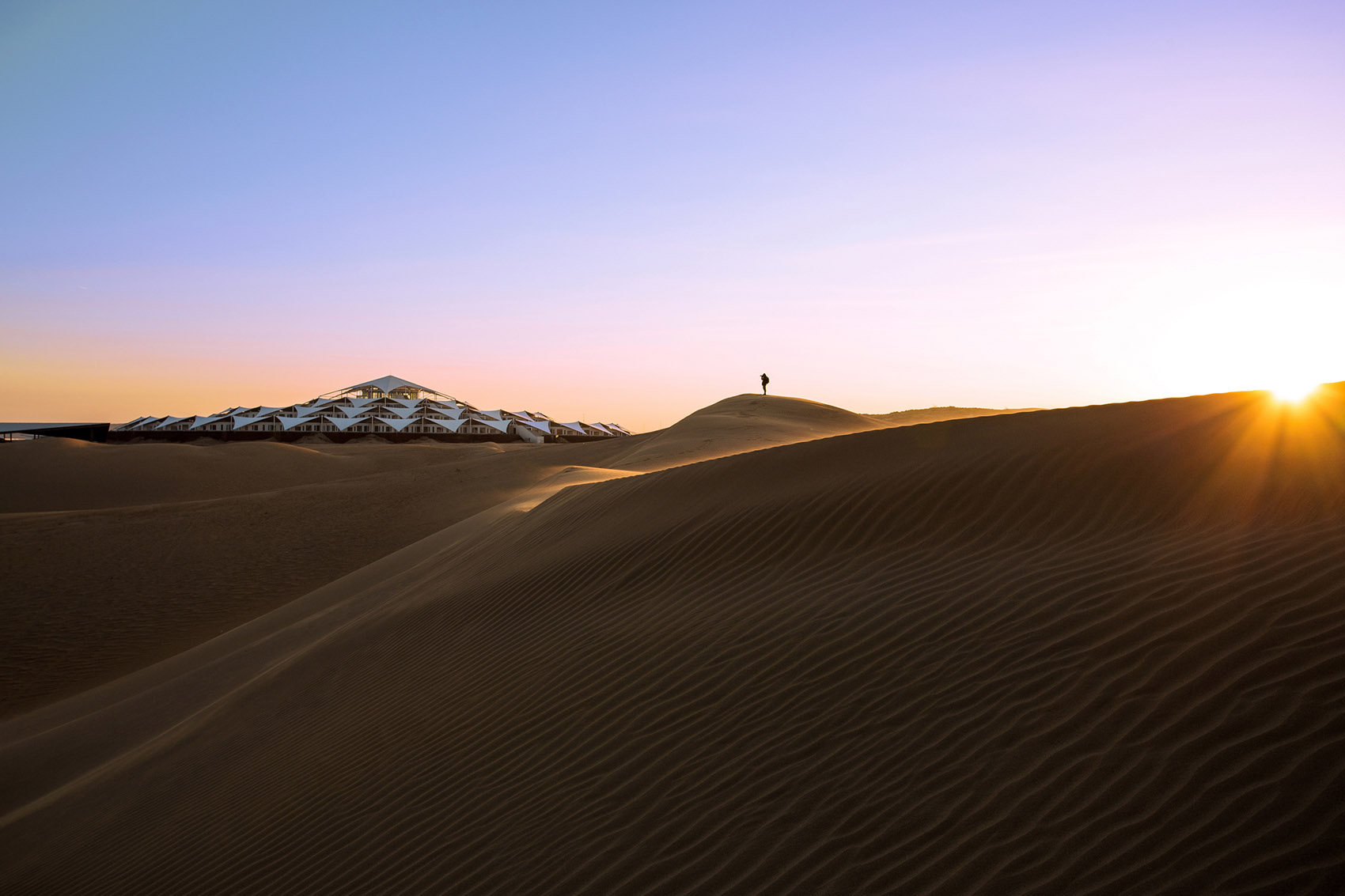
▼平面图,plan
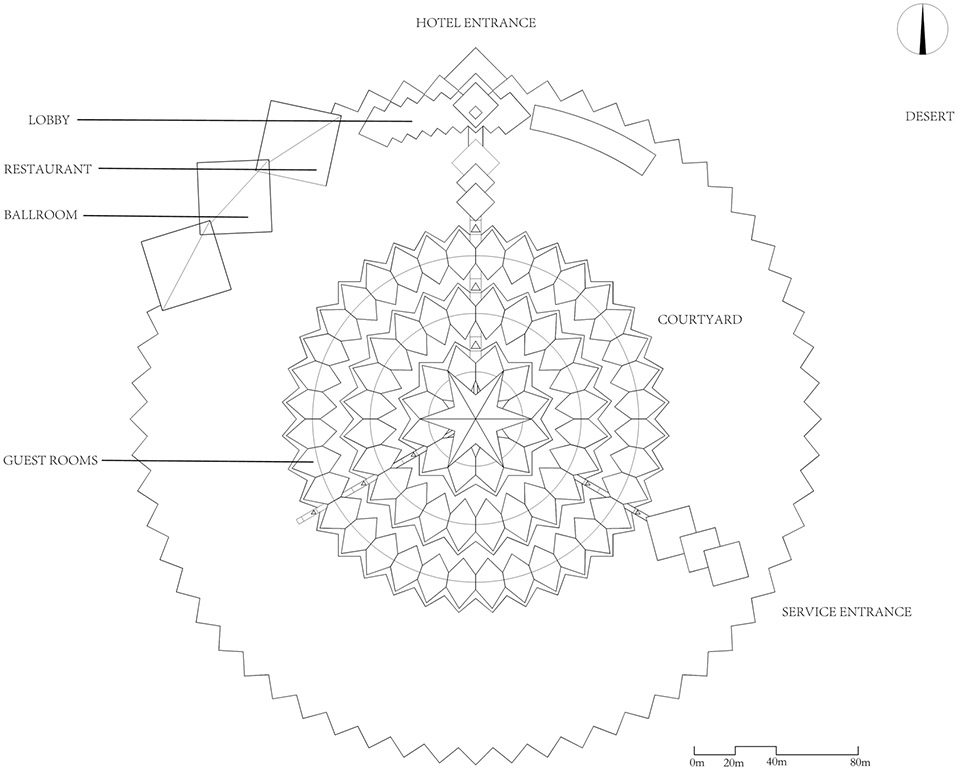
▼立面图,elevation

项目名称:响沙湾莲花酒店 项目地点:内蒙古,库布齐沙漠 业主单位:内蒙古响沙湾旅游集团 设计单位:PLAT ASIA(北京普拉特建筑设计有限公司) 设计团队:边保阳,郑东贤,前田聪志,李双全,乔文科,刀慧玲,李豆豆 设计类型:规划,建筑,室内,景观 施工图设计:北京华诚博远建筑工程有限公司 建筑摄影:存在建筑-建筑摄影; PLAT ASIA 建筑面积:30,700㎡ 占地面积:50,000㎡ 最大高度:40m 建筑结构:轻质钢结构 结构材料:钢,膜结构 装饰材料:砂 设计时间:2006-2014 建成时间:2016
Project Name: Xiangshawan Desert Lotus Hotel Location: Kubuqi Desert, Inner Mongolia, China Client: Xiangshawan Tourism Architects: PLAT ASIA Design Team: Baoyang Bian, Donghyun Jung, Satoshi Maeda, Shuangquan Li, Wenke Qiao, Huiling Dao, Doudou Li Type: Masterplan, Architecture, Interior, Landscape Construction Design: Beijing Huachengboyuan Engineering Technology Group Photograph: Arch-Exist; PLAT ASIA Total floor area: 30700㎡ Site area: 50,000㎡ Max Height: 40m Construction: Light Weight Steel Structure Structure material: Steel, Membrane Decoration material: Sand Design Period: 2006-2014 Completion time: 2016
